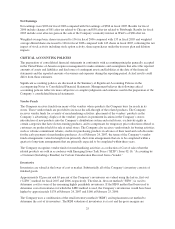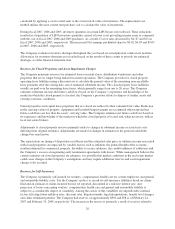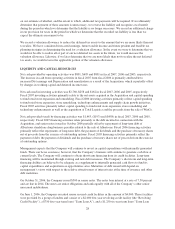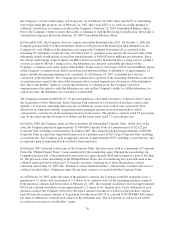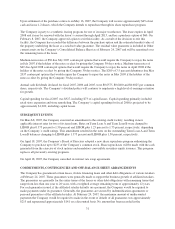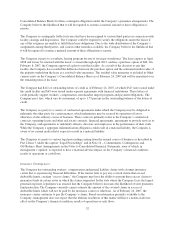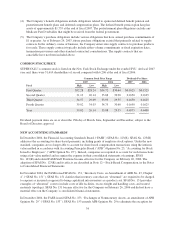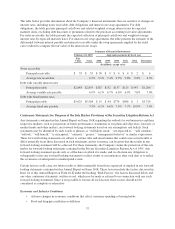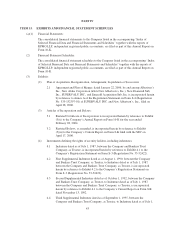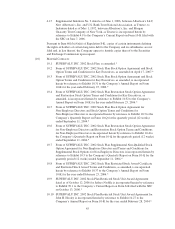Albertsons 2007 Annual Report Download - page 41
Download and view the complete annual report
Please find page 41 of the 2007 Albertsons annual report below. You can navigate through the pages in the report by either clicking on the pages listed below, or by using the keyword search tool below to find specific information within the annual report.nonmonetary exchanges of similar productive assets and replaces it with a general exception for exchanges o
f
nonmonetary assets t
h
at
d
o not
h
ave commerc
i
a
l
su
b
stance. A nonmonetary exc
h
ange
h
as commerc
i
a
l
su
b
stanc
e
if the future cash flows of the entit
y
are expected to chan
g
esi
g
nificantl
y
as a result of the exchan
g
e. SFAS
No. 1
5
3 became effective for the Company on February 26, 2006 and did not have a material effect on th
e
C
ompany’s conso
lid
ate
dfi
nanc
i
a
l
statements
.
I
n May 200
5
, the FASB issued SFAS No. 1
5
4, “Accounting Changes and Error Corrections—a Replacement of
APB Opinion No. 20 and FASB Statement No. 3” (“SFAS No. 154”). SFAS No. 154 requires retrospective
a
pplication as the required method for reportin
g
a chan
g
e in accountin
g
principle, unless impracticable or unles
s
a
pronouncement includes alternative transition provisions. SFAS No. 1
5
4 also requires that a change in
d
eprec
i
at
i
on, amort
i
zat
i
on or
d
ep
l
et
i
on met
h
o
df
or
l
ong-
li
ve
d
, non-
fi
nanc
i
a
l
assets
b
e accounte
df
or as a c
h
ang
e
in accountin
g
estimate effected b
y
a chan
g
e in accountin
g
principle. This statement carries forward the
g
uidanc
e
in APB Opinion No. 20, “Accounting Changes,” for the reporting of a correction of an error and a change i
n
a
ccounting estimate. SFAS No. 154 became effective for the Company on February 26, 2006 and did not have a
material effect on the Compan
y
’s consolidated financial statements.
I
n June 200
6,
the FASB ratified the consensuses of EITF Issue No. 0
6
-3
,
“How Taxes Collected from Customers
a
nd Remitted to Governmental Authorities Should Be Presented in the Income Statement (That Is, Gross versus
Net Presentation)” (“EITF 06-3”). EITF 06-3 indicates that the income statement presentation on either a gros
s
b
as
i
s or a net
b
as
i
so
f
t
h
e taxes w
i
t
hi
nt
h
e scope o
f
t
h
e
i
ssue
i
s an account
i
ng po
li
cy
d
ec
i
s
i
on. T
h
e Company’
s
a
ccountin
g
polic
y
is to present the taxes within the scope of EITF 06-3 on a net basis. The adoption of EITF 06-
3
in the first fiscal quarter of 2007 did not result in a change to the Company’s accounting policy and, accordingly,
did
not
h
ave a mater
i
a
l
e
ff
ect on t
h
e Company’s conso
lid
ate
dfi
nanc
i
a
l
statements.
I
n July 2006, the FASB issued Interpretation No. 48, “Accounting for Uncertainty in Income Taxes—an
I
nterpretat
i
on o
f
FASB Statement No. 109” (“FIN 48”). FIN 48 c
l
ar
ifi
es t
h
e account
i
ng
f
or uncerta
i
nty
i
n
i
ncome
taxes reco
g
nized in an entit
y
’s financial statements in accordance with SFAS No. 109, “Accountin
g
for Income
T
axes,” and prescribes a recognition threshold and measurement attribute for the financial statement recognitio
n
a
n
d
measurement o
f
a tax pos
i
t
i
on ta
k
en or expecte
d
to
b
eta
k
en
i
n a tax return. A
ddi
t
i
ona
ll
y, FIN 48 prov
id
e
s
g
uidance on subsequent dereco
g
nition of tax positions, financial statement classification, reco
g
nition of interest
a
nd penalties, accounting in interim periods, and disclosure and transition requirements. FIN 48 is effective for
the Company’s fiscal year beginning February 25, 2007, with early adoption permitted. The Company is in the
process of evaluatin
g
the impact of adoption of FIN 48.
I
n September 2006, the FASB issued SFAS No. 157, “Fair Value Measurements” (“SFAS No. 157”). SFAS
No. 1
5
7 clarifies the
p
rinci
p
le that fair value should be based on the assum
p
tions market
p
artici
p
ants would us
e
when pricing an asset or liability and establishes a fair value hierarchy that prioritizes the information used t
o
d
eve
l
op t
h
ose assumpt
i
ons. Un
d
er t
h
e stan
d
ar
d
,
f
a
i
rva
l
ue measurements wou
ld b
e separate
l
y
di
sc
l
ose
db
y
l
eve
l
within the fair value hierarch
y
. SFAS 1
5
7 is effective for the Compan
y
’s fiscal
y
ear be
g
innin
g
Februar
y
24
,
2008, with early adoption permitted. The Company is in the process of evaluating the impact of adoption of
S
FA
S
No. 1
5
7
.
I
n September 2006, the FASB issued SFAS No. 1
5
8, “Employers’ Accounting for Defined Benefit Pension and
Other Postretirement Plans – an amendment of FASB Statements No. 87, 88, 10
6
and 132
(
R
)
”
(
“SFA
S
No. 1
5
8”). SFAS No. 1
5
8 requires an emplo
y
er that sponsors one or more sin
g
le-emplo
y
er defined benefit plan
s
to (a) recognize the overfunded or underfunded status of a benefit plan in its statement of financial position,
(
b
) recogn
i
ze as a component o
f
ot
h
er compre
h
ens
i
ve
i
ncome, net o
f
tax, t
h
ega
i
ns or
l
osses an
d
pr
i
or serv
i
ce
costs or credits that arise durin
g
the period but are not reco
g
nized as components of net periodic benefit cost
pursuant to SFAS No. 87, “Employers’ Accounting for Pensions”, or SFAS No. 106, “Employers’ Accountin
g
f
or Postret
i
rement Bene
fi
ts Ot
h
er T
h
an Pens
i
ons”, (c) measure
d
e
fi
ne
db
ene
fi
tp
l
an assets an
d
o
bli
gat
i
ons as o
f
the date of the emplo
y
er’s fiscal
y
ear-end, and (d) disclose in the notes to financial statements additional
information about certain effects on net periodic benefit cost for the next fiscal year that arise from delaye
d
3
5


